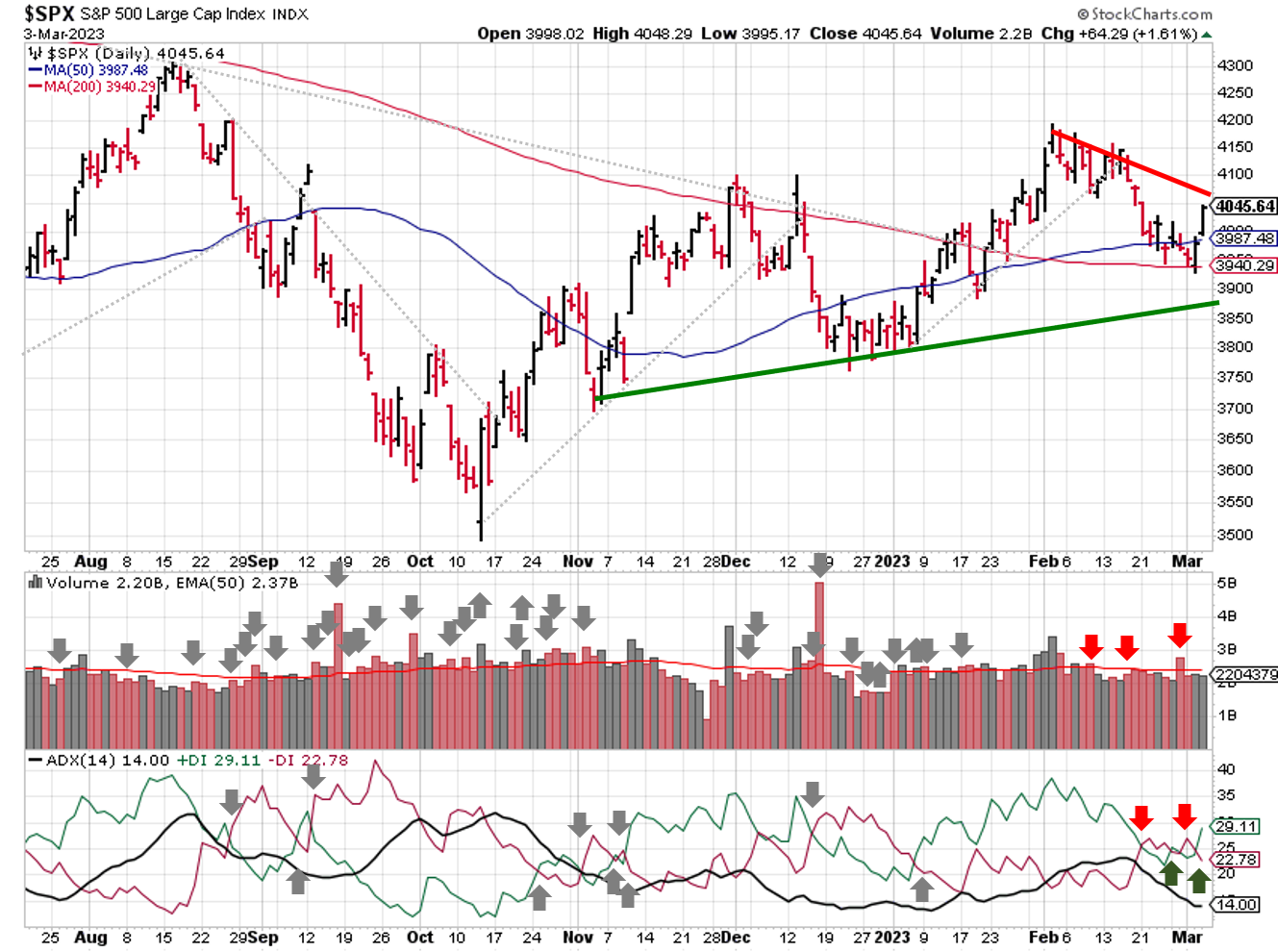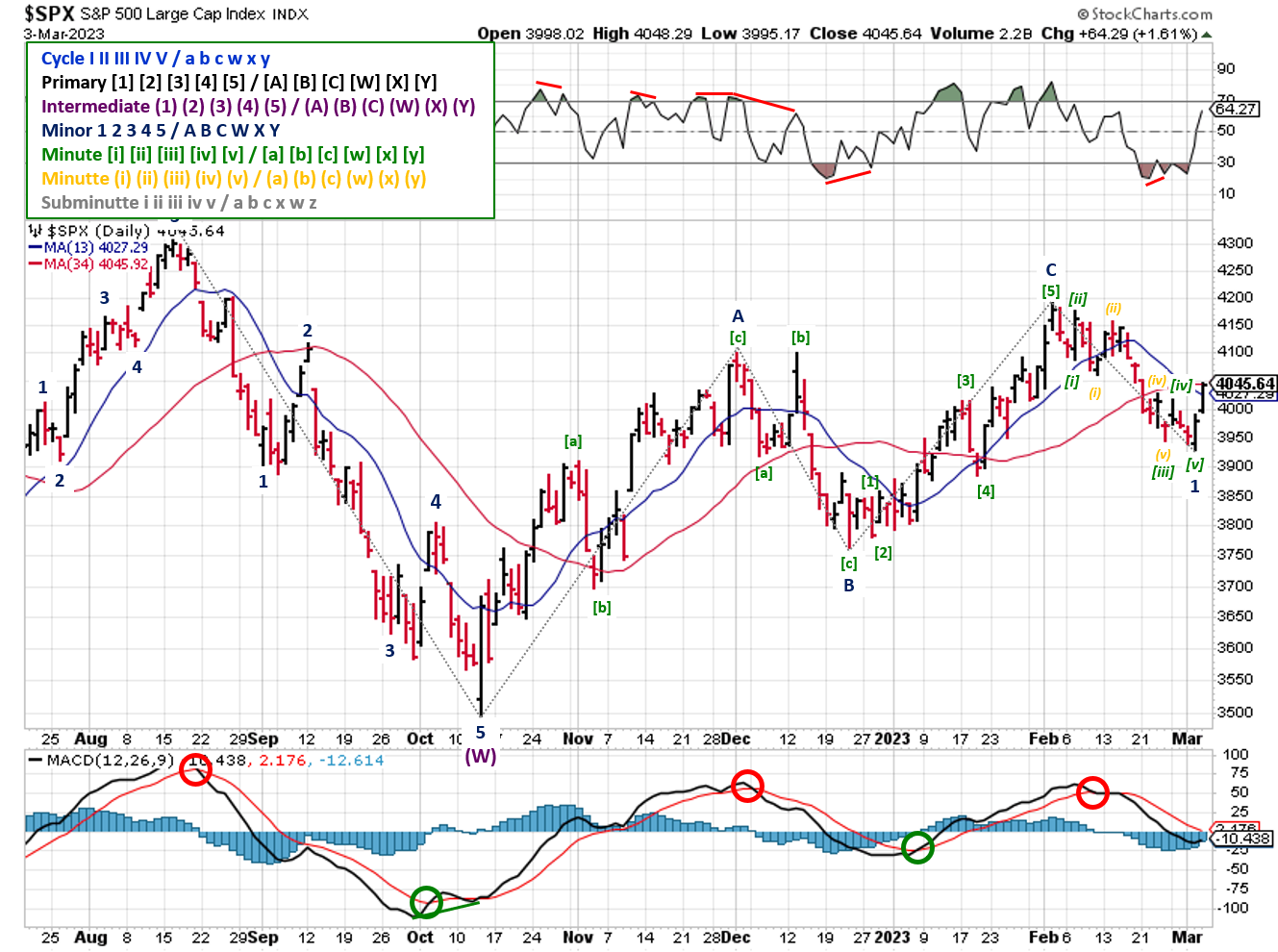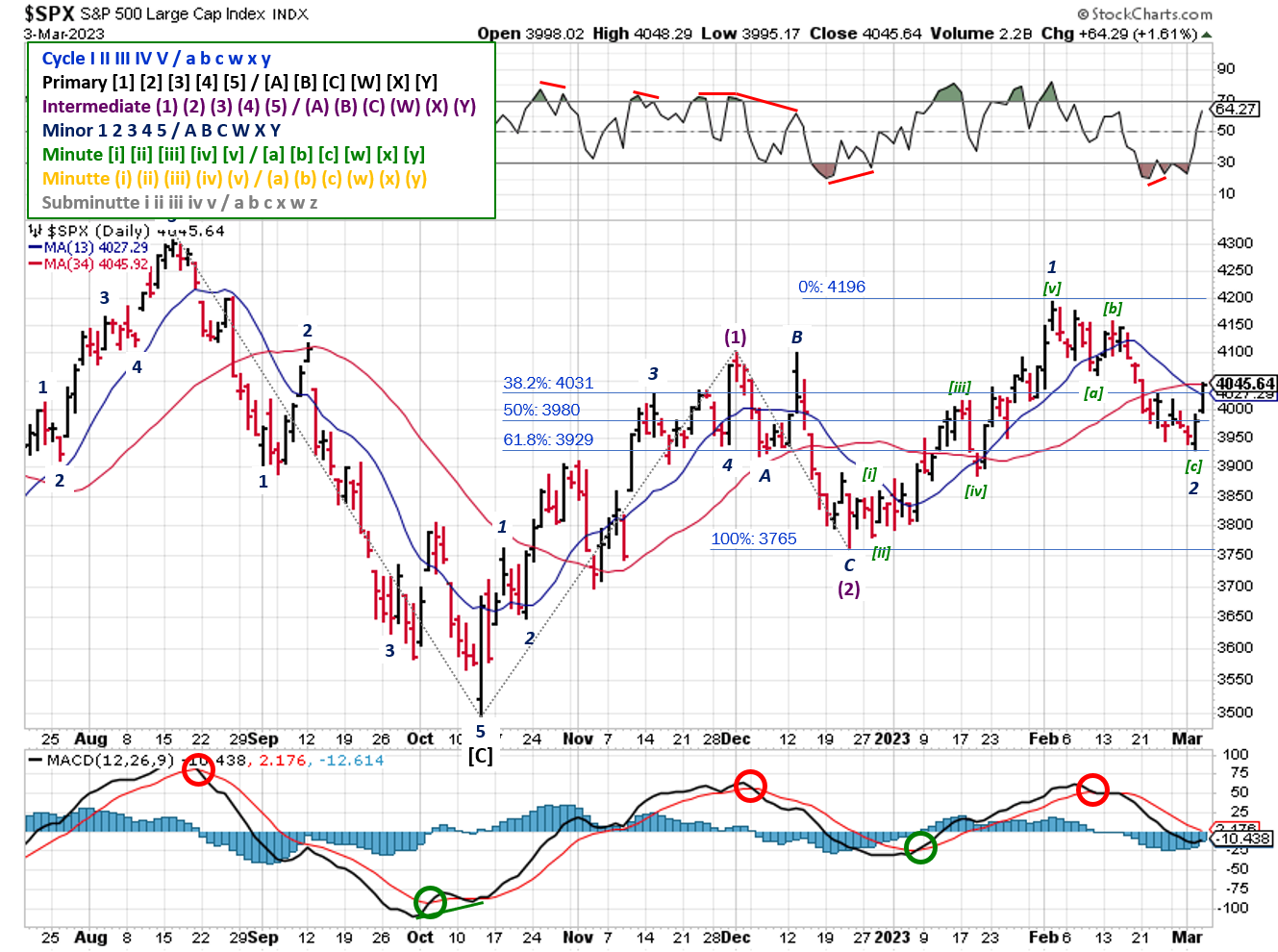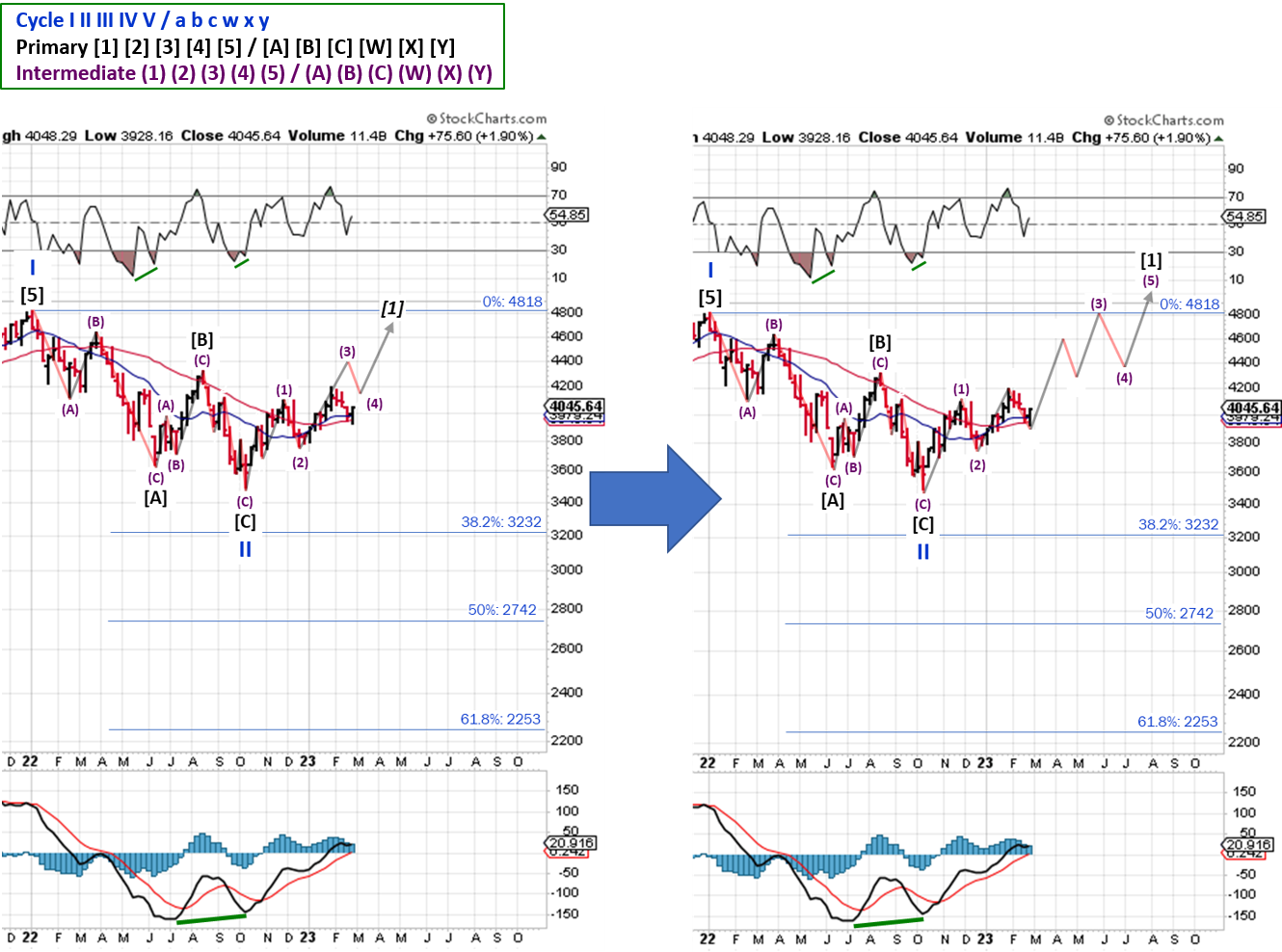Stock Market Outlook
For The Week Of March 5th = Uptrend
INDICATORS
-
ADX Directional Indicators: Uptrend
Price & Volume Action: Uptrend
Elliott Wave Analysis: Mixed
The S&P500 ($SPX) rose 1.9% for the week, bouncing off the 200-day moving average on Thursday and reclaiming the 50-day moving average on Friday.
2023-03-05-SPX Trendline Analysis - Daily
The ADX directional indicators flipped back to an uptrend Friday, after whipsawing twice last week. The indicator itself declined since first turning bearish 2 weeks ago, suggesting weakening price trends.
The price & volume signal switched back to an uptrend on Friday as well, as the SPX climbed back above the 50-day. The low level of trading volume accompanying the moves on Thursday and Friday is concerning, suggesting that institutional buying was not the reason for the jump higher.
Although the market reversed higher, as expected by the Elliott Wave analysis last week, the signal remains mixed; no change in key levels from last week (3765 and 4196).
2023-03-05- SPX Elliott Wave Analysis - Daily - Primary Y (Bearish)
Based on the price action last week, the subdividing count took over for the diagonal count, with a completed Minor 1. A Minor 2 can be expected take the SPX back towards the February high (4196) in 3 waves.
2023-03-05- SPX Elliott Wave Analysis - Daily - Primary 1 (Bullish)
After reviewing the long term counts (see updates below), the short-term waves for the bullish count needed to be promoted one level higher, going back to October, in order to stay synchronized. So Minute [ii] Minor 2 completed at the 61.8% retracement level on Thursday. A typical 3rd wave is 1.618 times the size of the 1st wave, putting an initial Minute [iii] Minor 3 target at 4,626.
COMMENTARY
Economic data releases were basically flat (i.e. little to no change), yielding no clear direction for the state of the economy. Of course, traditional financial media had not problem spinning each release in the direction they're currently favoring, which doesn't help your decision making.
As of Friday, most of the S&P500 companies have reported earnings: revenue/sales are up 5.6% year over year, while earnings are down 2.9% (per Bloomberg).
As discussed in prior blog posts, sustained inflation would eventually create negative profit margins when a company's costs rose faster than their prices. During 2022, profit margins declined y/y, but remained positive; companies offset higher costs of doing business with higher prices on goods and services.
Now we look to for inflation to impact the revenue/sales side of the equation, when customers can no longer afford the higher prices and/or cut back on spending all together.
This week, potential market moving events center on employment: job openings (JOLTS) on Wednesday and non-farm payrolls (NFP) / unemployment data on Friday.
Best To Your Week!
P.S. If you find this research helpful, please tell a friend.
If you don't, tell an enemy.
Sources: Bloomberg, CNBC, Federal Reserve Bank of St. Louis, Hedgeye, U.S. Bureau of Economic Analysis, U.S. Bureau of Labor Statistics
Long-Term Elliott Wave Updates for March
2023-03-05- SPX Elliott Wave Analysis - Daily - Primary Y (Bearish)
2023-03-05- SPX Elliott Wave Analysis - Daily - Primary 1 (Bullish)
Share this Post on:

How to Make Money in Stocks: A Winning System in Good Times and Bad.
It's one of my favorites.
I regularly share articles and other news of interest on:
Twitter (@investsafely)
Facebook (@InvestSafely)
LinkedIn (@Invest-Safely)
Instagram (@investsafely)
Invest Safely, LLC is an independent investment research and online financial media company. Use of Invest Safely, LLC and any other products available through invest-safely.com is subject to our Terms of Service and Privacy Policy. Not a recommendation to buy or sell any security.
Charts provided courtesy of stockcharts.com.
For historical Elliott Wave commentary and analysis, go to ELLIOTT WAVE lives on by Tony Caldaro. Current counts can be found at: Pretzel Logic, and 12345ABCDEWXYZ
Once a year, I review the market outlook signals as if they were a mechanical trading system, while pointing out issues and making adjustments. The goal is to give you to give you an example of how to analyze and continuously improve your own systems.
- 2015 Performance - Stock Market Outlook
- 2016 Performance - Stock Market Outlook
- 2017 Performance - Stock Market Outlook
- 2018 Performance - Stock Market Outlook
- 2019 Performance - Stock Market Outlook
- 2020 Performance - Stock Market Outlook
IMPORTANT DISCLOSURE INFORMATION
This material is for general communication and is provided for informational and/or educational purposes only. None of the content should be viewed as a suggestion that you take or refrain from taking any action nor as a recommendation for any specific investment product, strategy, or other such purpose. Certain information contained herein has been obtained from third-party sources believed to be reliable, but we cannot guarantee its accuracy or completeness.
To the extent that a reader has any questions regarding the applicability of any specific issue discussed above to his/her individual situation, he/she is encouraged to consult with the professional advisors of his/her choosing. Invest Safely, LLC is not a law firm, certified public accounting firm, or registered investment advisor and no portion of its content should be construed as legal, accounting, or investment advice.
The material is not to be construed as an offer or a recommendation to buy or sell a security nor is it to be construed as investment advice. Additionally, the material accessible through this website does not constitute a representation that the investments described herein are suitable or appropriate for any person.
Hypothetical Presentations:
Any referenced performance is “as calculated” using the referenced funds and has not been independently verified. This presentation does not discuss, directly or indirectly, the amount of the profits or losses, realized or unrealized, by any reader or contributor, from any specific funds or securities.
The author and/or any reader may have experienced materially different performance based upon various factors during the corresponding time periods. To the extent that any portion of the content reflects hypothetical results that were achieved by means of the retroactive application of a back-tested model, such results have inherent limitations, including:
Model results do not reflect the results of actual trading using assets, but were achieved by means of the retroactive application of the referenced models, certain aspects of which may have been designed with the benefit of hindsight
Back-tested performance may not reflect the impact that any material market or economic factors might have had on the use of a trading model if the model had been used during the period to actually manage assets
Actual investment results during the corresponding time periods may have been materially different from those portrayed in the model
Past performance may not be indicative of future results. Therefore, no one should assume that future performance will be profitable, or equal to any corresponding historical index.
The S&P 500 Composite Total Return Index (the "S&P") is a market capitalization-weighted index of 500 widely held stocks often used as a proxy for the stock market. Standard & Poor's chooses the member companies for the S&P based on market size, liquidity, and industry group representation. Included are the common stocks of industrial, financial, utility, and transportation companies. The S&P is not an index into which an investor can directly invest. The historical S&P performance results (and those of all other indices) are provided exclusively for comparison purposes only, so as to provide general comparative information to assist an individual in determining whether the performance of a specific portfolio or model meets, or continues to meet investment objective(s). The model and indices performance results do not reflect the impact of taxes.
Investing involves risk (even the “safe” kind)! Past performance does not guarantee or indicate future results. Different types of investments involve varying degrees of underlying risk. Therefore, do not assume that future performance of any specific investment or investment strategy be suitable for your portfolio or individual situation, will be profitable, equal any historical performance level(s), or prove successful (including the investments and/or investment strategies describe on this site).






